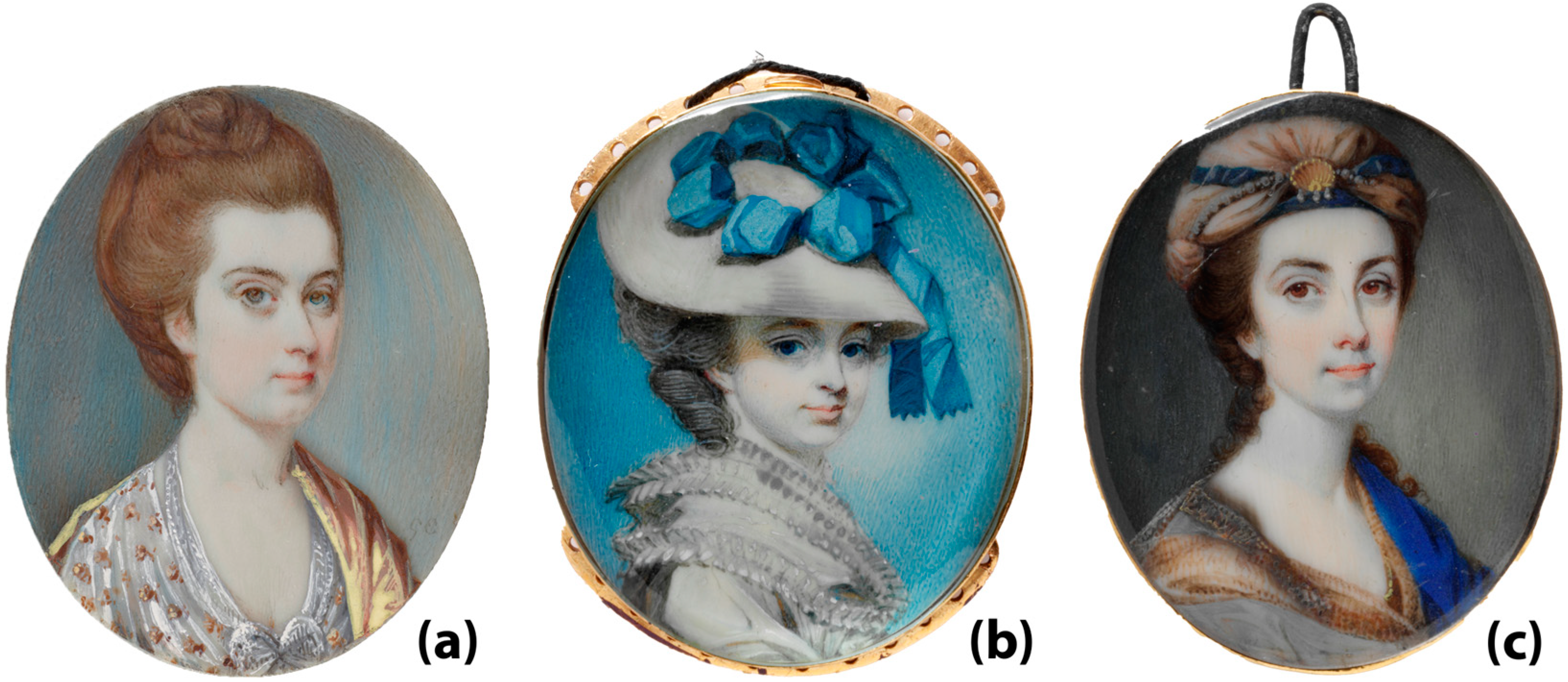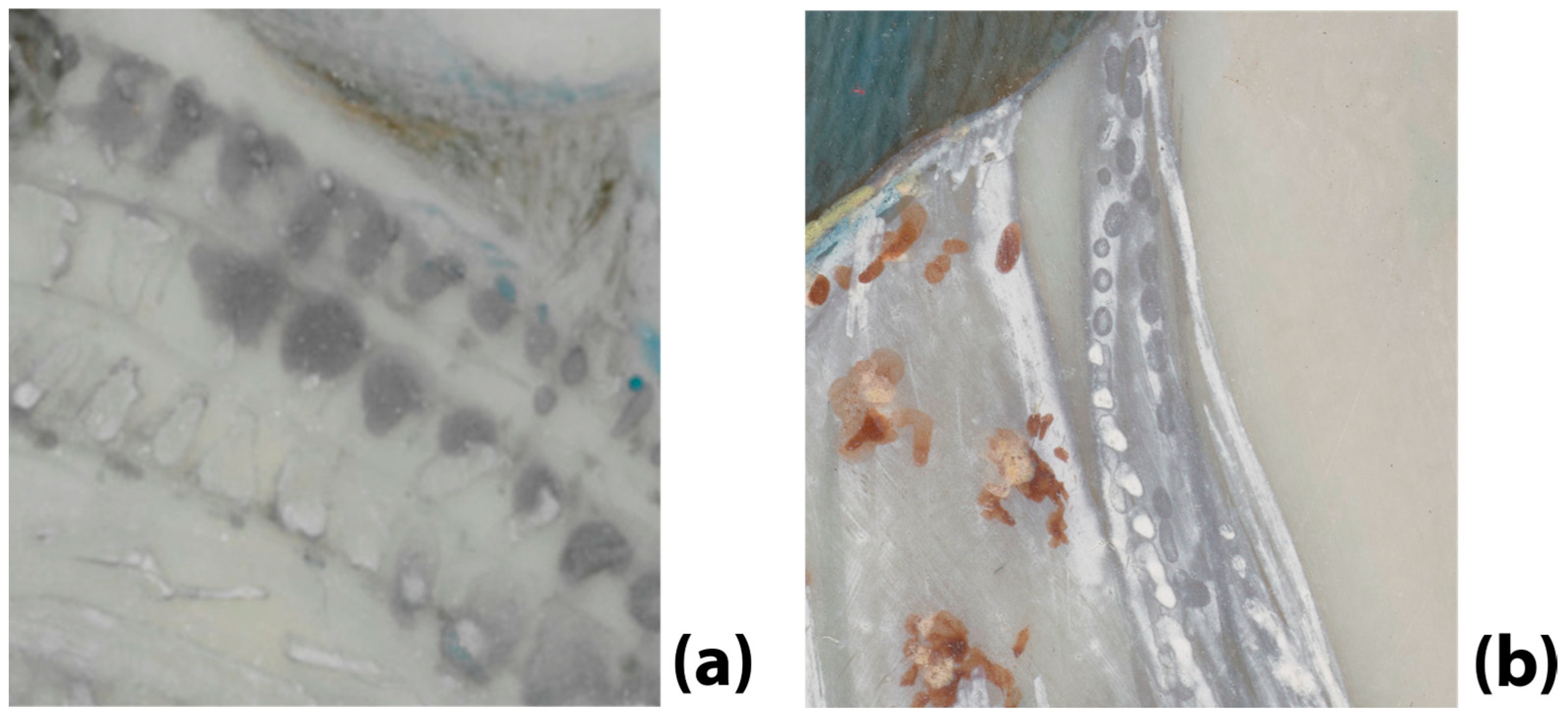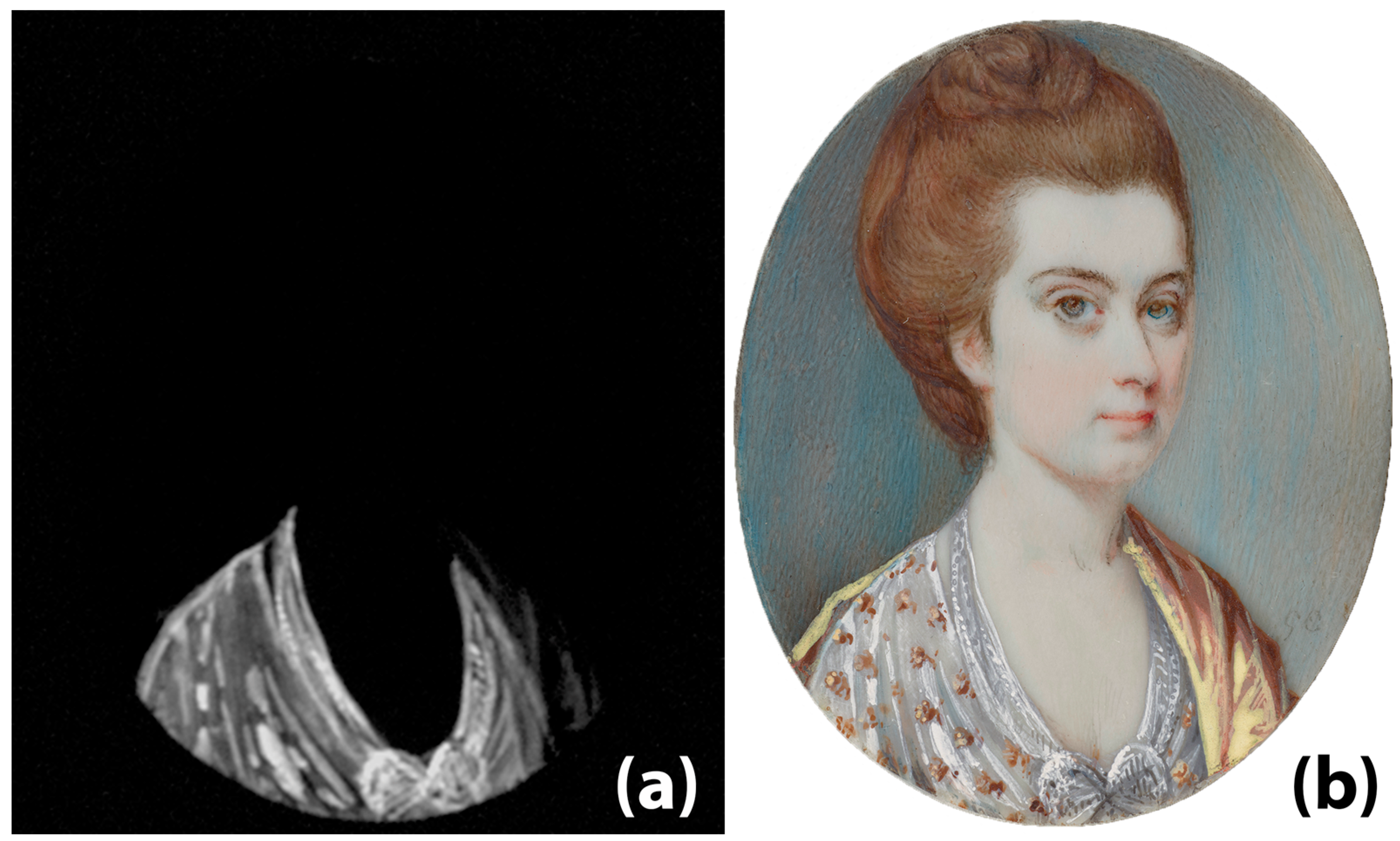Bismuth White (Bismuth Oxychloride) and Its Use in Portrait Miniatures Painted by George Engleheart
Abstract
:1. Introduction
2. Materials and Methods
3. Results
- Miniature P.22-1937 was analysed to look at the discolouration of some of the areas of the dress;
- Miniature P.20-1929 was analysed to identify the blue pigments;
- Miniature P.26-1922 was analysed to look at the discolouration on the reverse of the object.
4. Discussion
Funding
Data Availability Statement
Acknowledgments
Conflicts of Interest
References
- Bismuth. Available online: https://www.webmineral.com/data/Bismuth.shtml (accessed on 23 March 2024).
- Bismuth. Available online: https://www.mindat.org/element/Bismuth (accessed on 23 March 2024).
- Bismoclite. Available online: https://www.webmineral.com/data/Bismoclite.shtml (accessed on 22 June 2024).
- Bismoclite. Available online: https://www.mindat.org/min-683.html (accessed on 29 May 2024).
- Bismoclite. Available online: https://en.wikipedia.org/wiki/Bismoclite (accessed on 22 June 2024).
- Bismoclite. Available online: https://www.mineralienatlas.de/lexikon/index.php/MineralData?mineral=Bismoclite (accessed on 22 June 2024).
- Bismoclite. Available online: https://www.handbookofmineralogy.org/pdfs/bismoclite.pdf (accessed on 22 June 2024).
- Burgio, L.; Clark, R.J.; Hark, R.R.; Rumsey, M.S.; Zannini, C. Spectroscopic investigations of Bourdichon miniatures: Masterpieces of light and color. Appl. Spectrosc. 2009, 63, 611–620. [Google Scholar] [CrossRef] [PubMed]
- Gold, R. Reconstruction and Analysis of Bismuth Painting. In Painted Wood: History and Conservation, Proceedings of a Symposium Organized by the Wooden Artifacts Group of the American Institute for Conservation of Historic and Artistic Works, Williamsburg, VA, USA, 11–14 November 1994; Dorge, V., Howlett, F.C., Eds.; Getty Conservation Institute: Los Angeles, CA, USA, 1998; pp. 166–178. [Google Scholar]
- Trentelman, K. A note on the characterization of bismuth black by Raman microspectroscopy. J. Raman Spectrosc. 2009, 40, 585–589. [Google Scholar] [CrossRef]
- Trentelman, K.; Turner, N. Investigation of the painting materials and techniques of the late-15th century manuscript illuminator Jean Bourdichon. J. Raman Spectrosc. 2009, 40, 577–584. [Google Scholar] [CrossRef]
- Spring, M.; Grout, R.; White, R. ‘Black Earths’: A Study of Unusual Black and Dark Grey Pigments used by Artists in the Sixteenth Century. In The National Gallery Technical Bulletin; National Gallery: London, UK, 2003; Volume 24, pp. 96–114. Available online: http://www.nationalgallery.org.uk/technical-bulletin/spring_grout_white2003 (accessed on 22 June 2024).
- Buzzegoli, E.; Kunzelman, D.; Giovannini, C.; Lanterna, G.; Petrone, F.; Ramat, A.; Sartiani, O.; Moioli, P.; Seccaroni, C. The use of dark pigments in Frà Bartolomeo’s paintings. In Art et Chimie, la Couleur: Actes du Congrès; CNRS: Paris, France, 2000; pp. 203–208. [Google Scholar]
- Čechák, T.; Trojek, T.; Šefců, R.; Chlumská, Š.; Třeštíková, A.; Kotrlý, M.; Turková, I. The use of powdered bismuth in Late Gothic painting and sculpture polychromy. J. Cult. Herit. 2015, 16, 747–752. [Google Scholar] [CrossRef]
- Mayerne Manuscript Ms. Sloane 2052 (Full Plain Transcript). Available online: https://artechne.hum.uu.nl/node/94995 (accessed on 22 June 2024).
- De Mayerne, T.T. Lost Secrets of Flemish Painting: Including the First Complete English Translation of the De Mayerne Manuscript, B.M. Sloane 2052; Alchemist: Hillsville, VA, USA, 2001. [Google Scholar]
- Wood, W. (1790–1808). Memorandum of miniatures painted and finished by William Wood, of the Royal Academy. National Art Library, London, Great Britain, accession number MSL/1944/433-435.
- Tingry, P.F. The Painter and Varnisher’s Guide, or a Treatise, Both in Theory and Practice, on the Art of Making and Applying Varnishes: On the Different Kinds of Painting; And on the Method of Preparing Colours Both Simple and Compound; Printed for G. Kearsley, by J. Taylor: London, UK, 1804. [Google Scholar]
- Field, G. Chromatography; or, a Treatise on Colours and Pigments, and of Their Powers in Painting; Charles Tilt: London, UK, 1835. [Google Scholar]
- Angelin, E.M.; Babo, S.; Ferreira, J.L.; Melo, M.J. Raman microscopy for the identification of pearlescent pigments in acrylic works of art. J. Raman Spectrosc. 2019, 50, 232–241. [Google Scholar] [CrossRef]
- Peng, Q.; Tellefsen, M. Bismuth Oxychloride—A Multifunctional Color Additive. Cosmet. Toilet. Mag. 2003, 118, 53–62. Available online: https://img.cosmeticsandtoiletries.com/files/base/allured/all/image/2019/07/ct.CT_118_09_053_06.pdf (accessed on 22 June 2024).
- CI 77163. Available online: https://cosmetics.specialchem.com/inci-ingredients/ci-77163 (accessed on 22 June 2024).
- Lavallee, C.; Beale, K. What about bismuth? Bismuth oxychloride as a high performance pigment. Paints Coat. Ind. 2001. Available online: https://www.pcimag.com/articles/84064-what-about-bismuth (accessed on 11 May 2024).
- Suzuki, E.M. Infrared spectra of US automobile original finishes (1998–2000). IX. Identification of bismuth oxychloride and silver/white mica pearlescent pigments using extended range FT-IR spectroscopy, XRF spectrometry, and SEM/EDS analysis. J. Forensic Sci. 2014, 59, 1205–1225. [Google Scholar] [CrossRef] [PubMed]
- Harley, R.D. Artists’ Pigments c. 1600–1835, 2nd ed.; Butterworths: Sevenoakes, UK, 1982. [Google Scholar]
- Mayer, R. The Artist’s Handbook of Materials and Techniques; Faber & Faber: London, UK, 1973. [Google Scholar]
- Mayer, R. A Dictionary of Art Terms and Techniques; Adam and Charles Black Ltd.: London, UK, 1969. [Google Scholar]
- Kremer Pigmente Bismuth White. Available online: https://www.kremer-pigmente.com/en/shop/pigments/54100-bismuth-white.html (accessed on 11 May 2024).
- de Mayerne Manuscript, Ms. Sloane 2052, Folio 6 Verso. Available online: https://artechne.hum.uu.nl/node/95224 (accessed on 23 May 2024).
- Bismuth Nitrate. Available online: https://cameo.mfa.org/wiki/Bismuth_nitrate (accessed on 11 May 2024).
- Gettens, R.J.; Fitzhugh, E.W.; Feller, R.L. Calcium carbonate whites. In Artists’ Pigments, A Handbook of Their History and Characteristics; Roy, A., Ed.; Archetype Publications: London, UK, 1993; Volume 2. [Google Scholar]
- Shell White. Available online: https://cameo.mfa.org/wiki/Shell_white (accessed on 22 June 2024).
- Pearl White (Pigment). Available online: http://vocab.getty.edu/page/aat/300380453 (accessed on 22 June 2024).
- Bismuth White (Pigment). Available online: http://vocab.getty.edu/page/aat/300013728 (accessed on 22 June 2024).
- Bismuth Oxychloride. Available online: https://cameo.mfa.org/wiki/Bismuth_oxychloride (accessed on 22 June 2024).
- Foskett, D. Miniatures: Dictionary and Guide; Antique Collectors’ Club: Woodbridge, Suffolk, UK, 1987. [Google Scholar]
- Reynolds, G. English Portrait Miniatures; revised ed.; Cambridge University Press: Cambridge, UK, 1988. [Google Scholar]
- Bell, I.M.; Clark, R.J.H.; Gibbs, P.J. Raman spectroscopic library of natural and synthetic pigments (pre- ≈ 1850 AD). Spectrochim. Acta Part A Mol. Biomol. Spectrosc. 1997, 53, 2159–2179. [Google Scholar] [CrossRef] [PubMed]
- Burgio, L.; Clark, R.J.H. Library of FT-Raman spectra of pigments, minerals, pigment media and varnishes, and supplement to existing library of Raman spectra of pigments with visible excitation. Spectrochim. Acta Part A Mol. Biomol. Spectrosc. 2001, 57, 1491–1521. [Google Scholar] [CrossRef] [PubMed]
- RRUFF Database. Available online: http://rruff.info/ (accessed on 22 June 2024).
- Hark, R.; Yale University, West Haven, CT, USA; Millunzi, O.; Daughters of the American Revolution, Washington DC, USA; Ordiway, A.; The Andy Warhol Museum, Pittsburgh PA, USA. Personal communication, 2022.
- Hark, R.R.; Houston, K.R.; Burgio, L.; Millunzi, O.; Ordiway, A.; Derbyshire, A. William Wood (1769–1809) and his “Memorandum of Miniatures” Manuscripts: A New Biography, Art Historical Context, and Technical Analysis. Materia 2024. submitted. [Google Scholar]
- V.V. A.A. Ullmann’s Encyclopedia of Industrial Chemistry—Pigments, Inorganic; Wiley: Hoboken, NJ, USA, 2006; p. 120. [Google Scholar] [CrossRef]
- Coombs, K. The Portrait Miniature in England; V&A Publications: London, UK, 1998. [Google Scholar]
- Burgio, L.; Cesaratto, A.; Derbyshire, A. Comparison of English portrait miniatures using Raman microscopy and other techniques. J. Raman Spectrosc. 2012, 43, 1713–1721. [Google Scholar] [CrossRef]
- Aslet, W.; Burgio, L.; Cachaud, C.; Derbyshire, A.; Rutherford, E. An English artist at the Valois Court: A portrait of Henri III by Nicholas Hilliard. Burlingt. Mag. 2019, 161, 102–111. [Google Scholar]
- Evans, M.; Pieragostini, E. Renaissance Watercolours: From Dürer to Van Dyck; V&A Publications: London, UK, 2020. [Google Scholar]
- Concin, A. Face Value: The Power of Portraiture in European Renaissance Courts. In A Taste for the Renaissance: A Dialogue between Connections; Al Thani Collection: Paris, France, 2024; pp. 387–394. [Google Scholar]
- Gilburt, J. A Study of the Materials and Techniques of English Portrait Miniaturists from 1700–1820. Master’s Thesis, RCA/V&A Joint Course in Conservation, London, UK, May 1993. [Google Scholar]






| Miniature | Area | Bismuth (point XRF) | Bismuth oxychloride (Raman) |
|---|---|---|---|
 P.22-1937 | Pearl in headdress | ✓ | ✓ |
| Pale blue dress | ✓ | ✓ | |
 P.20-1929 | Hat brim | ✓ | ✓ |
| Ruff highlights | ✓ | ✓ | |
| Hair strands | ✓ | v | |
| Ruff (darkened) | ✓ | ✓ | |
 P.26-1922 | Shawl highlights | ✓ | ✓ |
| Grey dress | ✓ | ✓ | |
| Dress white highlights | ✓ | ✓ |
Disclaimer/Publisher’s Note: The statements, opinions and data contained in all publications are solely those of the individual author(s) and contributor(s) and not of MDPI and/or the editor(s). MDPI and/or the editor(s) disclaim responsibility for any injury to people or property resulting from any ideas, methods, instructions or products referred to in the content. |
© 2024 by the author. Licensee MDPI, Basel, Switzerland. This article is an open access article distributed under the terms and conditions of the Creative Commons Attribution (CC BY) license (https://creativecommons.org/licenses/by/4.0/).
Share and Cite
Burgio, L. Bismuth White (Bismuth Oxychloride) and Its Use in Portrait Miniatures Painted by George Engleheart. Minerals 2024, 14, 723. https://doi.org/10.3390/min14070723
Burgio L. Bismuth White (Bismuth Oxychloride) and Its Use in Portrait Miniatures Painted by George Engleheart. Minerals. 2024; 14(7):723. https://doi.org/10.3390/min14070723
Chicago/Turabian StyleBurgio, Lucia. 2024. "Bismuth White (Bismuth Oxychloride) and Its Use in Portrait Miniatures Painted by George Engleheart" Minerals 14, no. 7: 723. https://doi.org/10.3390/min14070723






